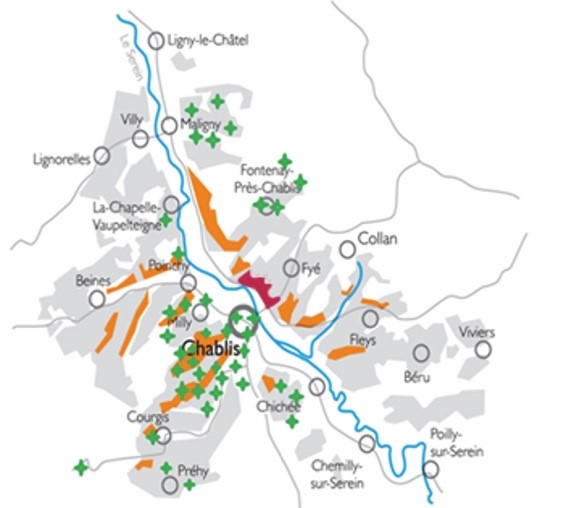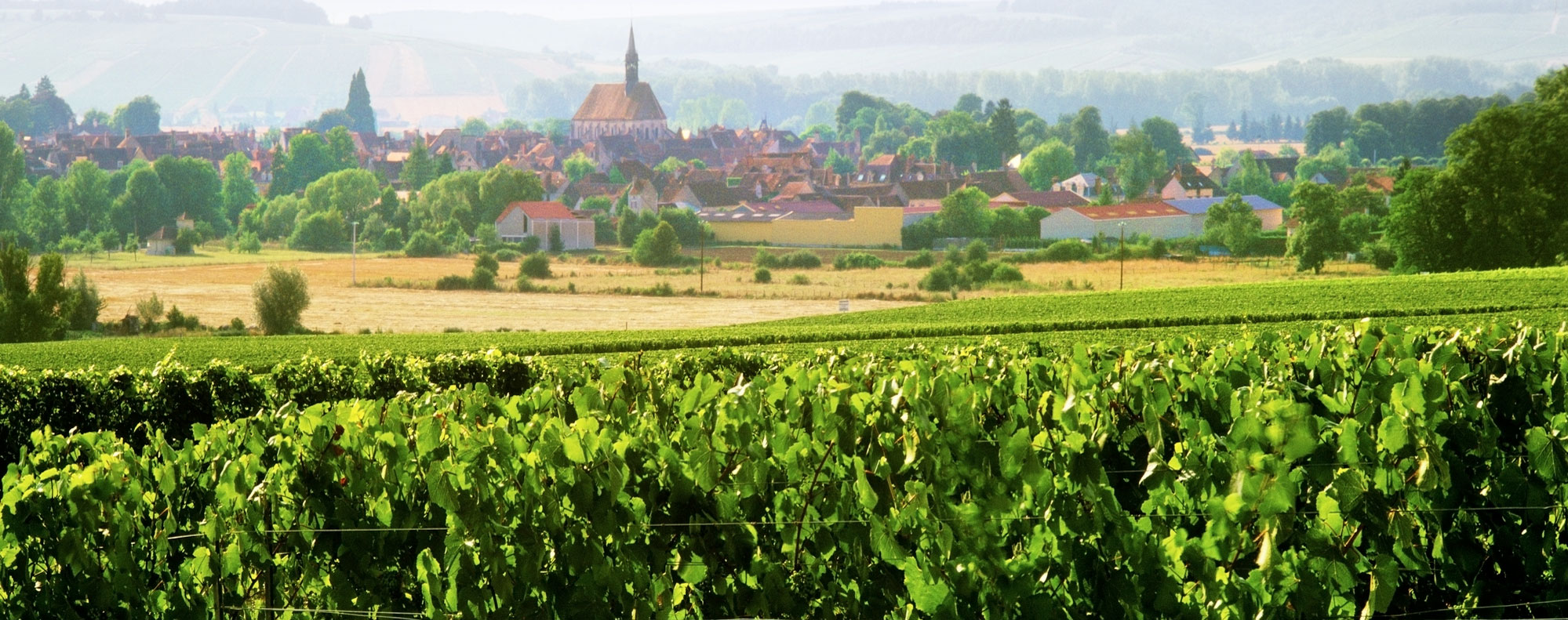That's one of the conclusions from a study into vineyard and winemaking practices in the region.
The study was divided into two parts with 34 wine producers who have produced at least one Chablis Premier Cru taking part in in-depth interviews to uncover a typology of practices in the Protected Designation of Origin (PDO), which is known for its mineral wines. Of these 34 participants, 27 also took part in short follow-up interviews eight months later which explored how Chablis producers conceptualise wine minerality and its link to production practices.

Figure 1 (above) shows where the respondents’ wineries (green crosses) are located in the town of Chablis and neighbouring municipalities in the administrative region of Burgundy, France.
The Chablis winegrowing area is crossed by the river Serein, from north-west to south-east. The top Chardonnays bearing the PDO Chablis Grand Cru are located in a very specific area with optimal agronomical conditions (slope, exposure and soil characteristics) on the right bank of the river (the red area in Figure 1). Right below in the hierarchy there are the wines from Chablis Premier Cru PDO (orange areas) with 17 main vineyards. The wider area producing Chablis and Petit Chablis wines are shown as grey areas in Figure 1. These have less restrictive production specifications than Premier and Grand Crus.
Winemaking practices
The research by Heber Rodrigues, Dominique Valentin, Méven Otheguy, and Jordi Ballester – published earlier this year in Oeno One (Vol. 56 No. 2) – found the following winemaking practices among Premier and Grand Crus producers:- 81% of respondents press the grapes with “gentle pressure”, believing this will produce better quality wines with less phenolic compounds, bitterness and herbaceous aromas. The respondents also stated that the level of pressure depends on parameters such as ripeness.
- Most producers (91%) said they carry out settling, of whom 53% aimed at a rather low turbidity (lower than 200 NTU). “It is an operation that is almost mandatory, who would carry out fermentations without settling first?” asked one respondent. Limiting must turbidity makes it possible to foster the production of positive fermentative aroma, to the detriment of other volatile compounds, such as higher alcohols, which are generally considered to be responsible for negative odours in wines. But very low turbidity can negatively affect the alcoholic fermentation.
- 65% of the producers said they use commercial yeasts for the alcoholic fermentation, and 18% said they prefer native yeast. The former group explained that they use commercial yeasts because they are reliable and fast. “I used a lot of indigenous yeasts before, but I had too many stuck fermentation problems,” explained one.
- 79% reported that the fermentation takes less than five weeks.
- Regarding malolactic conversion, only 21% of the producers reported that they add commercial bacteria and 91% claimed not to have any stuck malolactic conversions. Those who use commercial bacteria do so for business and logistical reasons: “In April we are already being asked for wine, so I inoculate right after the alcoholic fermentation.”
- 97% of the producers said they filter their wines. “I really like the Kieselguhr filtration because it straightens the wine, that’s it. It makes it clean, straight, bright,” said one respondent.
- 85% of the producers have a bottling line equipped with inerting systems.
- Regarding ageing conditions, 38% of respondents said they use stainless-steel vats and 62% use both stainless-steel vats and oak barrels.
- The respondents are divided in terms of the stoppers they use: 64% reported using natural cork, while the rest preferred other cork alternatives, such as technical stoppers, screwcap or a combination of closure solutions based on the potential for ageing of the wine and marketing strategies.
From the interviews regarding minerality, they uncovered the following positive strategies:
- Alcoholic fermentation with indigenous yeasts or commercial yeasts providing they are neutral from an aromatic point of view. Comments from participants included: “I would favour indigenous yeasts… to maximize also the side, terroir effect, mineral effect”; “I will use yeasts… but yeasts that are neutral”.
- Avoiding cold temperatures during fermentation so they don’t exaggerate the fruitiness of the wines, which can mask wine minerality. The winemakers told the researchers: “…warmer alcoholic fermentation, around 23-25°C in order to make wines that express the terroir more than the fruit”.
- Using neutral vats (mostly stainless steel) to conduct fermentations and ageing as barrel fermentation and ageing can mask wine minerality. As one respondent said: “In order to have the strongest expression of minerality, you shouldn't mask it with oak, you should rather conduct the ageing in stainless-steel tanks.” Other respondents are less opposed to using oak, providing the barrels have been used for several vintages: “I would do 80% of winemaking in vats and the rest in barrels… We do not use new oak.”
- Long ageing is largely believed to be a positive factor for wine minerality: “We noticed in our winery that when we conduct longer ageing periods, we succeed in bringing out more minerality, in producing wines that have more tension than fruit and freshness.”
- Lees contact is a common practice in Chablis white wine production, producing two sensory effects on wine. First, lees keep the wine in a moderate reductive state preventing oxidation and, according to some respondents, sustaining mineral aromas (such as oyster shell): “Chablis wines are characteristic of minerality when they are in a slightly reductive state, not in oxidation... By reductive, I don't mean the H2S kind, I mean a slight reduction, not annoying, but reinforcing the taste of terroir.” Second, lees release some macromolecules (eg. mannoproteins), which can modify the mouthfeel perception (in particular tactile sensations) by increasing body or “fattiness” (gras in French). According to many respondents, this “fattiness” is negatively correlated with their idea of minerality: “…the further you push the ripeness, the more your wine will be round and fatty and rich as it will lose the straight, tense and crystalline character that represents better wine minerality in my opinion”.
What they did find, however, is that the Chablis winemakers believed that “because their wines are mineral their respective production practice is the best one for making mineral wines, without having deliberately chosen it to make mineral wines”.
Others admitted that the goal is not to maximise minerality at all costs, because very mineral wines can be unpalatable for some consumers: “It is still necessary to have fruit in a wine. Because, eventually, it has to be drinkable.” One respondent described what he would do to make the wine as mineral as possible: “I’d do everything in tanks, that is not what I do in my winery, but in this case, I’d do everything in tanks but … for as long as… 15, 16 months on lees… That would be really too mineral.”
Vineyard practices
Among the virtually ubiquitous viticultural practices in Chablis are soil maintenance, desuckering and trimming. All the respondents carry out soil maintenance to decrease the use of chemical herbicides. “There is nowadays a general trend of soil working again,” explained one respondent. In addition, a large majority (76%) reported disbudding.Mechanised harvesting is widely used (82%) in the Chablis area, where it is only forbidden in the PDO Grand Cru plots. The respondents highlight a big improvement in the machines over the last 30 years in terms of damage done to the grapes, as well as obvious economic and logistic advantages: “The positive points… are that we don’t have to manage staff… we can go from one plot to another easily. We can better adapt to the ripening of the grapes.”
Leaf removal is carried out by half of the respondents. The positive comments about this practice are that it helps ripening and improves air circulation, which limits disease development. It also facilitates harvesting by hand.
It is interesting to note that green harvesting is not a common practice in the Chablis area. The main reason given by the respondents is that it is not necessary if disbudding has been done properly. Some respondents also argued that green harvesting results in more vigorous vines the following year: “I think that it is a heresy. If we come to that, that means that we didn’t do a good work before. What I think is that, maybe I am wrong, I think that it has a negative effect. When we remove the lateral shoots and grapes, we give more vigour to the vine the next year.” Some respondents also added that since they struggle to reach a reasonably high yield, there is no point in doing a green harvest.
Regarding crop yield, 62% of the vineyards have an average yield of less than 55 hL/ha. The technical specifications of the Chablis appellations set the maximal yield at 60 hL/ha for Petit Chablis and Chablis, 58 hL/ha for Chablis 1er Cru and 54 hL/ha for Chablis Grand Cru. Several respondents said it is better to obtain a lower yield, because it is related to higher quality final wines; while some others said they prefer to maximise the yield: “We aim at obtaining the authorised yield … not less.” Some respondents related low yields to older vines, lower acidity levels, and unbalanced wines. “In Chablis we need some acidity,” was one comment. “Sometimes we have to harvest some very old sectors quite early, with very low yields when acidities drop and the aromas are untypical.” Another said: “From the very old vines… we will get less minerality and more richness.”
About a third of the respondents produce organic grapes. Many of the remaining two-thirds said they follow a sustainable production system, as explained by a wine producer: “I think that it’s necessary to act only when needed, but with the appropriate products. That is why for the moment I am not thinking about shifting to organic production. Because I want efficient products, but I want to use them only when it is necessary.”
The vineyard and minerality
The interviewees said the harvest date and therefore grape ripeness are very important factors when it comes to minerality. The harvest date must not be too early, in order to avoid greenness in the wines, or too late, to avoid over-ripeness, which, according to many respondents, has a negative effect on minerality. Some respondents add that a slow ripening of the grapes can have a positive effect as well. The reason given by the respondents is that it is necessary for maintaining acidity, which has been shown in previous studies to be an important sub-dimension of minerality, and for limiting overripe fruit notes: “(I would use) grapes from cooler hills… with a slow ripening process, if possible, not grapes which have been very exposed to the sun resulting in very fruity aromas… above all, never over-ripeness.”Many respondents seemed to find it important to keep moderate yields and ensure good concentration in the grapes to obtain mineral wines.
Removing weeds by ploughing instead of using herbicides is regarded by some respondents as favouring minerality in wines. “Coming back to ploughing gives wines a more intense minerality,” one respondent said. Another commented: “I have the feeling that ploughed vines, where no chemical herbicide is used, will tend to give wines with precisely this expression, of minerality, than vines on soil that is weeded and maybe too compacted … so that the roots are less likely to absorb from the terroir.”
Conclusion
The researchers found that many other factors seem to be more important than producing mineral wines, in particular tradition, logistical or economical issues and, more recently, philosophical attitudes like environmental protection or public health.But one of the interesting findings was that representation of minerality is influenced by the way in which the producers make wine. “For instance, neutral commercial yeasts are considered to be good for minerality by the producers using neutral commercial yeasts and native yeasts are perceived as favouring minerality by the producers using native yeasts,” the report concluded.
The best white Burgundies from IWC 2022.













.png)






